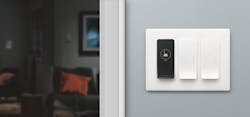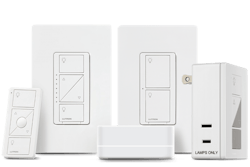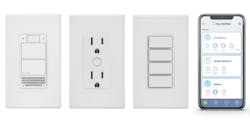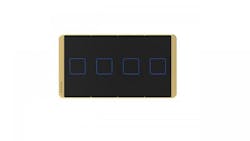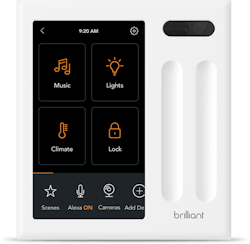Everything You Need to Know About Smart Light Switches
Homebuyer demand for smart technology has been on the rise for years, and if you have yet to embrace home tech, smart light switches are one of the best and easiest ways to do it. Here’s what you need to know.
Smart technology, and specifically lighting, can be one way for a home to offer a sustainable, modern, and accessible design—three trends that are huge right now and the foreseeable future, according to a new report from the New Home Trends Institute, a subsidiary of John Burns Real Estate Consulting.
Coldwell Banker’s 2018 Smart Home Marketplace Survey found 63% of the 2,000 homebuyers surveyed want a smart lighting system pre-installed into their new-home, yet only 24% already own a smart lighting system in their current home.
A 2019 survey from The National Association of Home Builders found 14% of homeowners currently have a smart lighting control system, but 36% would like to have it. Despite the majority of homeowners not currently utilizing these systems, they want them.
[ Read More: 13 INNOVATIVE SMART PRODUCTS WE SAW AT CES 2021 ]
What Type of Buyer Wants Smart Lighting?
Smart lighting can be one of the least complicated and intrusive forms of smart technology, and its capabilities can work for all types of buyers.
Specifically for the Millennial and Gen Z generations, smart technology is second nature.
“You have Millennials who are buying homes, you have Gen Zers who are renting homes, and these are people who are very, very tech-forward,” says Aaron Emigh, co-founder and CEO of Brilliant. “They’re looking for something modern and updated when they’re looking at a place to move into. And for them, modern means technology-enabled. There’s a great deal of demand for it.”
But that doesn’t mean smart technology, especially smart lighting, cannot be used for Boomers, Gen X, or the Silent Generation. Smart lighting can add a layer of accessibility, especially voice-controlled systems. If the design of a smart lighting system is clean and unobtrusive, it could be more welcomed.
“So many people today want to be able to age in place,” says Greg Rhoades, director of marketing at Leviton. “Being able to remain comfortable in your space, your home, for longer and being able to vocalize that as you enter a room or have it automated for you based upon your time of day and your general activities.”
Adding motion sensor functions or lighting schedules can lower energy consumption, and in turn, help the environment and lower a homeowner's electricity bill.
[ Read More: BRILLIANT BRINGS SMART TECH TO MULTI-FAMILY BUILDINGS ]
How Do I Pick a Smart Light Switch?
Deciding on a smart lighting system depends on the answers to a slew of questions:
- Is this a retrofit or new build?
- Will there be additional smart home technology in the home?
- What lighting capabilities does your target buyer want to control?
- Who is your target buyer?
- How does your target buyer want to control the system?
Once a strong understanding of both buyer desires and necessities are confirmed, then decisions can be made. Homes built before the 1980s will not have neutral wires throughout the home, which powers these smart systems, says TechHive. Single pole or multiple pole switches will also need to be taken into consideration.
Remember, simplicity is always best.
“But too many bells and whistles can overcomplicate and overstimulate,” writes The New Home Trends Institute. “2021 will see consumers seek a new balance with their tech: smarter, with seamless integration that supports our lifestyle, not consumes it.”
Smart light controls can come in three forms: bulbs, plugs, and switches.
According to CNET, smart switches are the best choice. Smart light switches feel the most natural to use, can work with existing fixtures, and are more permanent.
There are smart light switch options that are touchscreen, ones that stand out, others that blend in. Some work with Wi-Fi, others through Bluetooth, some through Z-Wave, some can be voice activated, and others rely on mobile apps. But one thing they all have in common, according to TechHive, is all smart switches will look different than the traditional light toggle.
Deciding between how to control a smart light switch comes down to who will be using it, but a large share of people enjoy having voice control.
The National Kitchen and Bath Association’s 2021 Trends Report found 44% of surveyed residential professionals see voice-activated lighting controls as a big want from buyers. A lighting system that allows users to set schedules for different times in the day are less popular overall, but they are much more popular among Millennials, the report says.
[ Read More: 5 HIGH-TECH SHOWERS THAT ARE SURE TO IMPRESS ]
6 Smart Light Switches On the Market
Caseta by Lutron
Lutron’s Caseta system offers controls of multiple bulbs without the need for additional smart bulbs. Some functions include dimming, scheduling, and scenes. Caseta also offers a Sunset Tracker that will turn lights on once the sun settles. Multiple lights can be controlled and scheduled for scenes, such as bedtime, movie night, and game night. The Smart Away setting will turn the lights on and off like normal during vacations. Caseta can be used with Amazon Alexa, Google Assistant, Apple HomeKit, Sonos, SmartThings, Carrier, Honeywell, and more, making it a good choice for buyers with many smart controls.
Decora Smart by Leviton
The Decora Smart line by Leviton offers normal smart light switches, but also dimmer switches and switches with both capabilities. It runs via Wi-Fi and can work with Amazon Alexa, Google Assistant, SmartThings, and more. This is a no-hub-required light switch and all voice controls are connected into the switch itself. Lights can also be controlled and monitored through the My Leviton app. Lights can be scheduled, based on sunrise or sunset, used to create scenes, and includes a five year limited warranty.
NOON Lighting System
The NOON light switch is designed for homeowners who embrace tech and love modern design. It only takes one switch, deemed the “Director,” to control all lights, and every type of residential bulb works with this system. The Director features a touchscreen OLED display that connects wirelessly to up to 10 NOON extension switches and helps to expand the lighting system throughout the home. All can also be controlled through a mobile app. Occupants can schedule lights, set scenes, and the app goes a step further to remember certain daily routines to make lighting control that much easier. NOON’s system even includes a motion sensored night light. It works via Wi-Fi, Bluetooth, and requires neutral and ground wire. NOON offers a pro membership, too.
Smart Touch Switch Panels by Hogar
Hogar offers full home systems from lighting to temperature controls, but the company does sell standalone smart switches. The Smart Touch Switch Panels dims and controls scenes, and the company says it makes retrofitting easy. Its design is futuristic and entirely glass, but its touch sensors claim to be highly sensitive. Hogar also says installation takes two minutes with no additional wiring needed. It works through Z-Wave, which is suitable for homes that want or use a wide array of smart devices. Touch switch panels are also available in a multitude of layouts in either black or white.
Smart Dimmer Switch by Brilliant
Brilliant’s smart home system works with a wide array of partners, such as Sonos, Honeywell, Ring, Amazon Alexa, Hue, and more. Brilliant’s system is only available as a whole home system, meaning smart light controls are only the beginning. Lighting scenes for morning, dinner, or bedtime are also paired with music, temperature, and locks. Multiple Smart Dimmer Switches can be installed throughout the home to control lighting in any room. It works with smart bulbs and regular lights, and Brilliant offers several different switch panels and colors to choose from. These smart switches offer app, motion, and voice control.
Philips Hue Smart Lighting
The Philips Hue system offers two options: a full blown experience or a simple start. The simple option works via Bluetooth, meaning it only works within a certain range. Homeowners would need Philip Hue smart bulbs. The app can control up to 10 bulbs, but the Hue Bridge option works with a wider Zigbee network, which opens up many more possibilities. It can set routines, control up to 50 lights, and offers a much larger range. Hue Bridge includes voice control with the pairing of either Amazon Alexa or Google Assistant, light dimmer, timers, schedules, and millions of colors of light.
